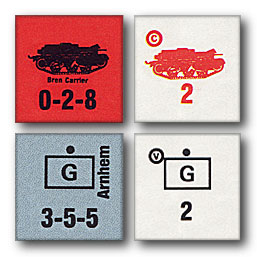This article needs additional citations for verification. (January 2015) |


A counter is usually a small cardboard square moved around on the map of a board wargame to represent relevant information or determine certain things. The first wargame based on cardboard counters was War Tactics or Can Great Britain Be Invaded? invented by Arthur Renals of Leicester in 1911.[1] The first wargame bringing counters to a mass-market was Tactics, invented by Charles S. Roberts in 1952. Traditional wargames typically have hundreds of counters (The Russian Campaign, 225; GI: Anvil of Victory, 856; Terrible Swift Sword, 2,000). Squad Leader had counters of different sizes: 520 1⁄2-inch counters and 192 5⁄8-inch, with the different sizes used for different purposes.
Boardgame counters are often closely related to military map marking symbols, such as those seen in the NATO standard APP-6a, and often include a simplified APP-6a representation as part of the counter.
- ^ Christopher Lewin, War Games and their History, Chapter 8, Fonthill Media, Stroud (GB) 2012, ISBN 978-1-78155-042-7
